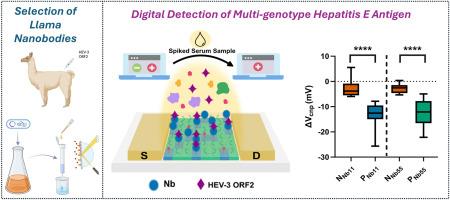Digital detection of hepatitis E antigen tailored for multiple genotypes using graphene transistors functionalized with nanobodies: End-to-end test development and optimization
IF 10.5
1区 生物学
Q1 BIOPHYSICS
引用次数: 0
Abstract
Hepatitis E virus (HEV), an emerging zoonotic pathogen and a major cause of acute hepatitis, requires advanced diagnostics for multi-genotype detection, quantification, and digital analysis to improve diagnosis and outbreak control. This study presents the development of a digital biosensor using graphene field-effect transistors (GFETs) functionalized with llama-derived nanobodies (Nbs) for detecting HEV ORF2 proteins. Using a Nb library, the features of high affinity and multi-genotype ORF2 recognition were demonstrated by ELISA and surface plasmon resonance (SPR) spectroscopy. These Nbs exhibited exceptional affinity for ORF2, with dissociation equilibrium constants (KD) reaching a value of 2.64 pM for genotype 3. The GFET sensors were co-functionalized with Nbs and polyethylene glycol (PEG), an antifouling element that enhances specificity. The sensors displayed robust signal responses to HEV-1 and HEV-3 ORF2, achieving amplitudes as high as 22.5 mV and a limit of detection (LOD) in the nanomolar range. Testing in spiked serum samples confirmed the biosensors' capability to distinguish positive and negative samples. A quantitative model was used to correlate antigen concentration with GFET response (ΔVcnp). We validated graphene interfacial transduction by comparing ΔVcnp with antigen surface density (ΓORF2) estimated by SPR. Furthermore, a theoretical model using Poisson–Boltzmann and Grahame equations explained key FET sensor behaviors related to ionic screening and molecular distance. This Nb-functionalized GFET biosensor represents a significant advancement in multi-genotype HEV antigen detection, with the added advantage of being digital, thereby facilitating the rapid monitoring and containment of HEV cases.

利用纳米体功能化的石墨烯晶体管对多种基因型戊型肝炎抗原进行数字化检测:端到端测试开发和优化
戊型肝炎病毒(HEV)是一种新兴的人畜共患病原体,也是急性肝炎的主要病因,需要先进的多基因型检测、量化和数字分析诊断技术,以改善诊断和疫情控制。本研究提出了一种使用石墨烯场效应晶体管(gfet)和羊驼衍生纳米体(Nbs)功能化的数字生物传感器的开发,用于检测HEV ORF2蛋白。利用Nb文库,通过酶联免疫吸附和表面等离子体共振(SPR)光谱分析证实了ORF2具有高亲和力和多基因型识别的特点。这些Nbs对ORF2表现出特殊的亲和力,基因型3的解离平衡常数(KD)达到2.64 pM。GFET传感器与Nbs和聚乙二醇(PEG)共功能化,聚乙二醇是一种增强特异性的防污元件。该传感器对HEV-1和HEV-3 ORF2表现出稳健的信号响应,振幅高达22.5 mV,检测限(LOD)在纳摩尔范围内。对加标血清样本的测试证实了生物传感器区分阳性和阴性样本的能力。使用定量模型将抗原浓度与GFET反应联系起来(ΔVcnp)。我们通过比较ΔVcnp和SPR估计的抗原表面密度(ΓORF2)来验证石墨烯界面转导。此外,使用泊松-玻尔兹曼方程和格雷厄姆方程的理论模型解释了与离子筛选和分子距离相关的关键FET传感器行为。这种nb功能化的GFET生物传感器代表了多基因型HEV抗原检测的重大进步,具有数字化的额外优势,从而促进了HEV病例的快速监测和控制。
本文章由计算机程序翻译,如有差异,请以英文原文为准。
求助全文
约1分钟内获得全文
求助全文
来源期刊

Biosensors and Bioelectronics
工程技术-电化学
CiteScore
20.80
自引率
7.10%
发文量
1006
审稿时长
29 days
期刊介绍:
Biosensors & Bioelectronics, along with its open access companion journal Biosensors & Bioelectronics: X, is the leading international publication in the field of biosensors and bioelectronics. It covers research, design, development, and application of biosensors, which are analytical devices incorporating biological materials with physicochemical transducers. These devices, including sensors, DNA chips, electronic noses, and lab-on-a-chip, produce digital signals proportional to specific analytes. Examples include immunosensors and enzyme-based biosensors, applied in various fields such as medicine, environmental monitoring, and food industry. The journal also focuses on molecular and supramolecular structures for enhancing device performance.
 求助内容:
求助内容: 应助结果提醒方式:
应助结果提醒方式:


